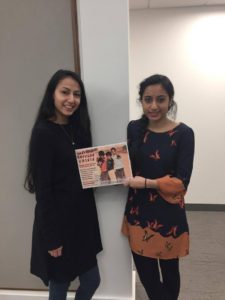By Sarah Frazer || Staff Writer

This past Thursday, February 24, students Sarah Hafiz ’18 and Sonia Hafiz ’20 gave a moving presentation about the ongoing Syrian refugee crisis. They described their experience working with refugees in Jordan and showed a movie that captured the plight of the refugees.
The Syrian conflict has created eleven million refugees, and hundreds of thousands of people have died from it. These refugees are largely concentrated in neighboring Jordan, Lebanon, and Turkey.
There are tradeoffs for which country would be better to leave to. Jordan and Lebanon are more culturally similar to Syria, while Turkey has considerably better living conditions. The refugees who leave Syria do so not as a choice, as many people in the documentary explained, “I didn’t decide to leave Syria, I was forced to leave Syria.”
Sarah and Sonia traveled to a refugee camp in Jordan in a program with other American students with the Islamic group, Helping Hand for Relief and Development.
Their group worked mostly with children and families, with the mindset that they should seek to provide skills necessary for long term development and empowerment, rather than merely providing handouts. For instance, one program they had was to teach women to sew, which would enable the refugees to sell the products that they sewed.
Sarah and Sonia’s group also visited orphanages, which they and the other students in the program were nervous about at first, since most of them did not speak Arabic, and they were not sure how to communicate with the children. However, once they arrived at the orphanage, they found creative ways of communication. For instance, the kids loved Snapchat filters, particularly the one with the dog face.
At the orphanage, the students heard many grim stories about what the children experienced during the Syrian Civil War. For instance, a quiet, six-year-old girl had witnessed her grandmother being hit with a shrapnel bomb. The girl was so traumatized that she could not speak for a year, although she is in the process of getting better.
When Sarah and Sonia’s group went to leave, the girl held onto the leg of one of their roommates, showing how much a little bit of kindness could affect the children.
Many shared these types of sinister stories, of parents being killed in front of their children, or the bodies of the children’s parents being dragged to their houses.
Even still, in spite of all the trauma they had experienced, the children tried to cope and have fun. They loved to play with the students’ cameras for instance. Meanwhile, Syria is only miles away, so they can hear the violence, and sometimes feel the ground shake from bombings. It is inescapable for refugees in these camps.
Some refugees prefer to live outside of the camps in tents, since some of the camps are dangerous, or they try to forge a new life in crowded cities.
Some of the refugees have been upgraded to living in trailers. While living in a trailer is looked down upon in the U.S., in Jordan, it is viewed as a big step up.
Often, refugees who live outside of camps may have families, for instance a mother and her children may live somewhere in a Jordanian city. In many, if not all cases, however, families are separated, which is why so many kids live in orphanages.
After Sarah and Sonia shared their experiences in Jordan, they presented a documentary, which further illustrated the inhumanity and brutality of the Syrian refugee crisis. Filmmakers in the movie also traveled to refugee camps to see for themselves the conditions in which refugees lived and the journeys those refugees took that brought them to the camps. One boy, who used to like going to school, was now too afraid to go because his experience in school in Syria was traumatizing. For older refugees, they have lost everything they built and accomplished in their lives in Syria. One man, Ismail, was studying at a university to become a teacher. He, along with tens of thousands of Syrians every month, was forced to leave that all behind.
Yet, the Syrian refugees that Sarah and Sonia met, as well as the ones in the documentary, still found a way to be hopeful. Many expressed their faith in God as a way for them to deal with all that has happened to them. One woman said of her children who were able to attend school in a refugee camp, “Thank God they are still in school.” This gratitude seems quite remarkable given all that has happened to these refugees since they were forced to flee their homeland.
Many students at F&M may want to help with humanitarian efforts to mitigate the effects of the refugee crisis. The Ware Institute emailed students about a service opportunity next Saturday, and, in record time, the spots for the event were all filled. Unfortunately, it is unlikely that there will be many more events like that. Given the Trump administration’s actions taken to ban refugees from entering the country, Americans wanting to aid Syrian refugees have very few options. The only thing students and Americans throughout the country can do, at this point, is to advocate for the U.S. to change its stance on admitting Syrian refugees.
These refugees, like the children in the orphanage in Jordan, fleeing chemical warfare from the Assad regime, beheadings, or a life of sex slavery from ISIS, need American assistance. News reporting is supposed to be objective, and, indeed, this is irrefutable fact. The Syrian Refugee crisis is the largest of its kind since World War II. The United States took the easy way out then, not accepting Jewish refugees fleeing the Nazis. We all know how that ended. Let us do better this time.
Sophomore Sarah Frazer is a staff writer. Her email is sfrazer@fandm.edu.